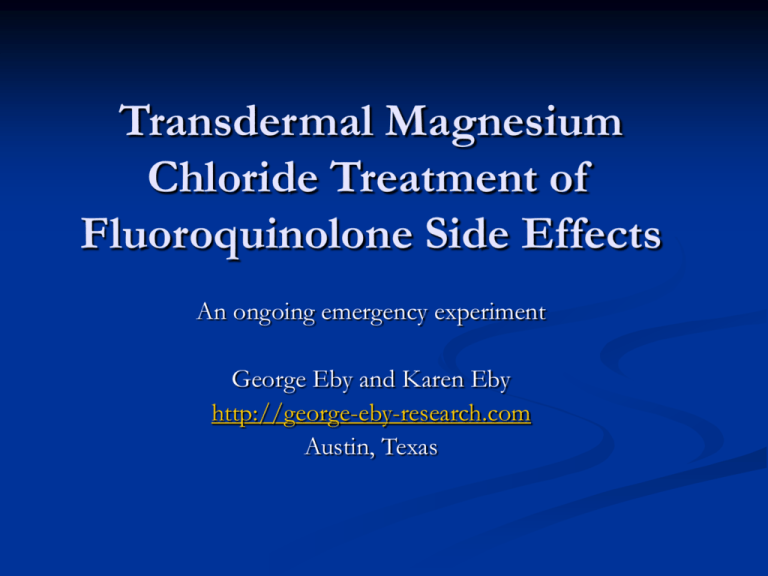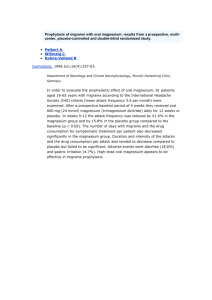Topical Magnesium Chloride Treatment of Fluoquinolone Side Effects
advertisement

Transdermal Magnesium Chloride Treatment of Fluoroquinolone Side Effects An ongoing emergency experiment George Eby and Karen Eby http://george-eby-research.com Austin, Texas Introduction Fluoroquinolone (and Quinolone) Effects Serious side effects are known but incidences are rarely reported in medical literature Yet, http://google.com - “fluoroquinolone” + “side effects” yields 114,000 pages Side effects - both immediate and long delayed (>1 year) symptom onset with potential for permanent injury with no known treatment Main side effects: Tendon ruptures and fibromyalgia-like symptoms Binding to DNA is mediated by magnesium ions Concentrates in skin and can photosensitize skin Depletes magnesium More specifically to side effects: Causes peripheral neuropathy, chronic pain, depression and other neuropsychiatric illnesses including insomnia, irritability, suicidal ideation, suicide, heart problems, skin problems (photosensitivity), Pseudomembranous colitis (bacterial infection of colon), Rhabdomyolysis, Stevens-Johnson syndrome, lowered seizure threshold, hypoglycemia, kidney stones and damage to all internal organs and outright death. Methods and Procedures Role of Transdermal Magnesium Chloride Magnesium chloride inactivates fluoroquinolones (see warning label on package inserts) Topically applied to skin, 33% magnesium chloride should bind with and neutralize fluoroquinolones concentrated in skin and perhaps body. Rapidly replaces depleted magnesium systemically to levels perhaps not achievable with oral magnesium Magnesium is a neuronal calcium channel blocker, like Lyrica Magnesium has sedating properties and helps induce sleep Mental Illnesses associated with Increasingly Severe Neuronal Magnesium Deficiency From : http://george-eby-research.com/html/depressionanxiety.html a 180 page report on magnesium and depression containing a magnesium and fluoroquinolone toxicity discussion. Results Case History # 1 A 32-year old, 5’3” 110 pound woman became toxic from prescribed 500 mg 2 t/d – 10 days ciprofloxacin after several days treatment. Symptoms included (cold water felt like boiling water), extreme pain in overworked right arm, severe Achilles’ heel tendon pain, insomnia, pain in all joints and limbs, vision impairment, irritability and depression. Before and after intoxication, blood panel was normal and fever was not present. Topical treatment with 33% magnesium chloride morning and evenings over both legs rapidly induced 14 to 16 hour sleep each day. After 10 days treatment with topical magnesium chloride, her symptoms ended, except for irritability and tendon pain. She remained neurologically symptom free for 5 months but relapsed from severe social/physiological stress becoming very irritable, depressed with suicidal ideation, and full body, severe chronic pain. Retreatment with topical magnesium for 10 days chloride terminated all complaints including tendon pain and irritability. Results Case History # 2 A 51 year-old 5’ 6” 140 pound woman (non perimenopausal and nonmenopausal) suffered from fibromyalgia-like symptoms including depression and full body chronic pain with tendon pain in all limbs (including toes and fingers) and vision impairment for 7 years after administration of ciprofloxacin during breast cancer surgery. Oral magnesium (500 mg / day) for two years slightly reduced symptomology, but did not eliminate them and did not improve sleep. Topical 33% magnesium chloride application (lower legs and arms) in evening rapidly and greatly improved sleep and terminated multi-year paresthesia (asleep feeling) in fingers. Topical application for _____ days, resulted in __________ Conclusions / Hypotheses Magnesium is not only depleted during fluoroquinolone intoxication, but magnesium homeostasis is hypothesized to be permanently down regulated (genetically?) to a level sometimes inconsistent with good mental or physical health Fluoroquinolone side effects are hypothesized to be very common, and severe side effects are much more common than previously believed, perhaps due to magnesium malnutrition Stress [psychological, physical, environmental, metabolic (including MSG and calcium)] is hypothesized to trigger relapses Topical magnesium chloride or other parenteral means of administering magnesium to higher than normal (+0.9 mMol) levels is hypothesized to be effective as treatment and prophylaxis for fluoroquinolone toxicity and should be investigated







